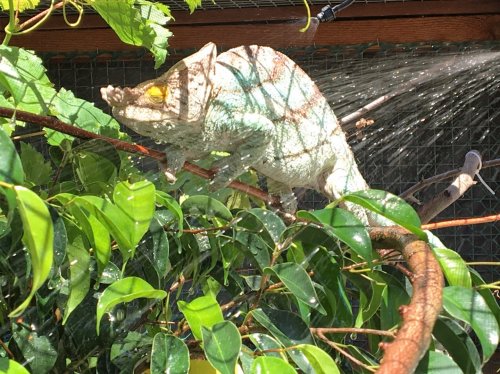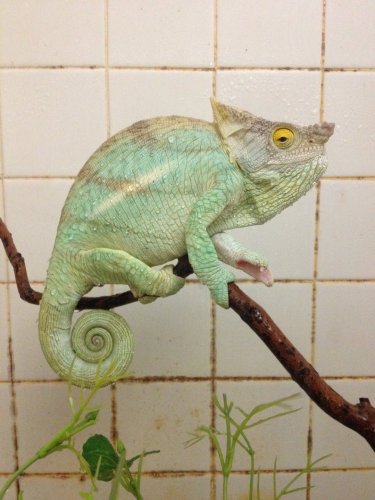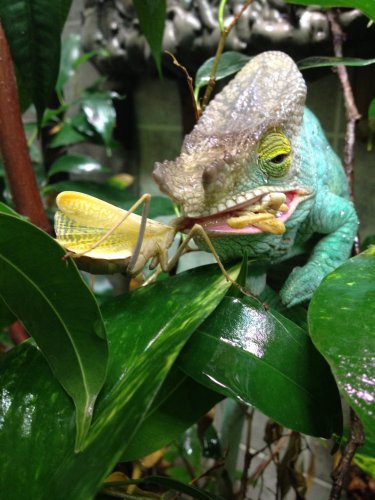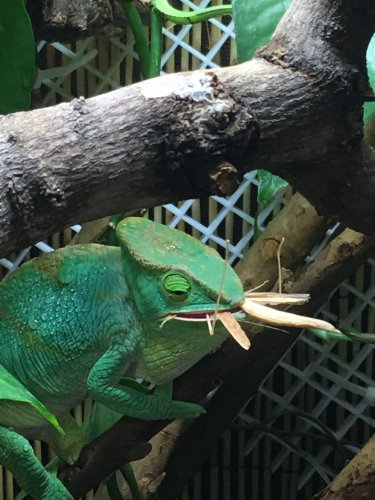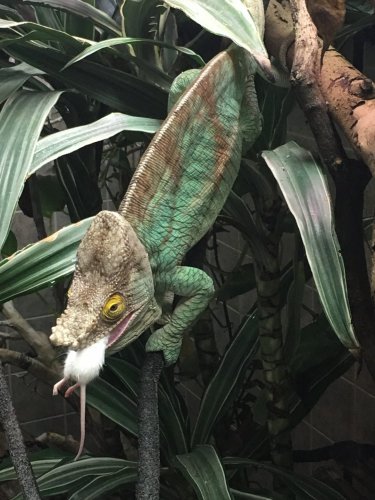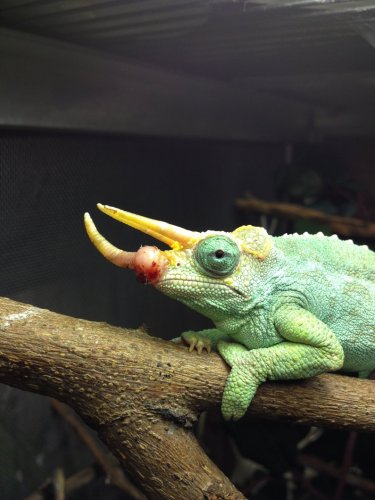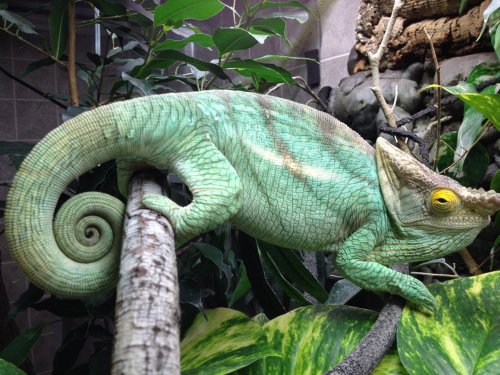OldChamKeeper
Chameleon Enthusiast
Good afternoon keepers.
Today's lecture shall be on the captive care of the Parson chameleon. I shall lay out the requirements for this animal's long term care as a pet, the information here pertains only to that aspect and breeding will not be covered. The goal of this post is to provide the reader with a baseline to work with and by no means is my way the only way to care for one of these giants. The following information is based upon my experiences in keeping these fat little monsters. At the end of this long semi-book will be a simple synopsis of my methods
A little about me. I have kept reptiles for over forty years of varying genus and species, primarily tropical in nature. I worked in the pet industry for nearly 15 years starting at age 11 and nothing captured my attention like a chameleon. Over those years I learned more than one could find in books, I learned about the importation process on the receiving end and the casualties that resulted from it. It wasn't long before I was keeping Parsons and during those early years I dealt directly with the issue of trying to rehab sick Parson chameleons.
One such Parson was a sad giant I came across in a cage at the importer. While buying animals for the pet store I managed, I purchased him for myself and took him home. He weighed a little over 700g but looked very thin to give you an idea of the condition he was in. Six months later, two vet visits and a lot of patience rewarded me with a healthy Male who, once rehabbed, was actually closer to 850g. He was that bad off when I got him. He lived another 7 years, the last two of which he had no teeth. The bone structures in the jaw that are their "teeth" had been attacked by a nasty dual bacterial infection resulting in him surviving the infection but having to gum his meals to death since the doc removed each quadrant. Fortunately for him I killed everything for him before hand feeding his old ass. When he passed he weighed 1049g. Not a small chameleon to say the least, especially for back in the 80's and 90's. His name was Hormone.
If you are reading this, then you are looking for information on how to care for one of these animals. I'm not an elitist ( they are plenty of those in this hobby ), nor a professional breeder (there are some out there now fortunately), nor somebody with too big of an ego to share how to keep one of these animals as a single pet. Since it seems we may be seeing so many more of these available in the near future between successful hatching's here in the US and also captive hatched ones coming from Europe and the recent imports, I felt maybe it was time to actually share my husbandry methods. That and I'm tired of getting hit up all the time. Ever since I started posting pictures of Atlas as he grows I've been hit up a lot on his care.
So, I'm going to remove the mystique. I say that since I've met a lot of Parson keepers with a elitist attitude who try to make the animal into the holy grail, and one that 'they' attained. So lets start with the first things many people want to know about.....
Q - How hardy is a Parson?
A- In my experience, and I've kept a lot of species, the Parson is one of the hardiest out there but with one serious caveat. Like any chameleon they need to be kept in the right environment. Do that, and these animals can live 15+ years no doubt. Don't do that, go cheap on the lighting, don't provide them with the huge amounts of water they require, don't pay attention to their nutritional needs, try and house more than one in a fancy enclosure because you want more than one, and they die. They are quite forgiving when the humidity fluctuates. They temperature range is actually pretty broad and easy to achieve in captivity.
Q- How much room do they need?
A- Not as much as some people think. These giants are not the most active chameleons I've ever kept. That said, I'm not saying they will be fine in a tiny 24"X24"x48" cage like many keep their Panthers. I keep Atlas in a custom cage I made out of a converted closet. His home is 8' long X 7' tall x 30" wide. However he only uses about two thirds of that. Parsons tend to find a spot they are comfortable in- and they sit there. Very very boring animal to watch. A Parson roaming all over the place is either an animal looking for a mate, or an animal very uncomfortable for some reason. Now I've seen people go nuts and built magnificent full room habitats for their legendary Parsons, but it's overboard. In some cases the habitats built are going to be problematic over time for the keeper to maintain.... think mold, cleaning, finding the animal, dead feeders, air circulation, fire hazards, and more. I'm not saying don't give your Parson a nice home, but for the beginner reading this for their first Parson- don't buy into the hype that you have to kick out your first born and convert their room for a Parson.
There is a vendor on this site who makes cages, Dragon Strand, they make a magnificent cage called the Atrium that is 45" wide X 22" deep X 44" high. By itself that is suitable for just raising a young Parson to around 500g. After that it needs a bigger area. The thing about these cages is that you can buy a second one and either stack it on top for a cage that is now 88" high or, as I would suggest, you attach it to the back of the first cage giving you a cage that is now 44" deep. It would be nearly a perfect square. Either configuration would work long term for a solo animal.
Yes, a square is an odd shaped cage to fit in your home, but it is easier than turning a whole room into a cage. The big Parsons are better off with some space to turn around, plus I've noticed mine prefer to use horizontal branches most of the time. That's what they rest on most of the day. A wider cage gives them plenty of room as opposed to a taller one. It's a bit of a blind spot some keepers have, thinking that chameleons want just a tall cage but how much of that tall cage do they actually use? Many I've seen just find a height they like and then just use that section of their cage because its the sweet spot in the cage for the animal. Instead make the majority of the cage the sweet spot.
Inside this space you would create pathways going in circles at different heights. You'll find the Parson will use them and this size cage is good for a single male Adult of up to 800g in my opinion. They don't move around a lot but will use the space over time. However if you really want a 'palace', buy four of these cages and make one large habitat. Doing this You can build one cage that is 45" wide X 44" deep X 88" high. Much better than converting a whole room. Cheaper than building a greenhouse for some. Easy as all hell to outfit for the animal's needs and easier still when it comes to breaking it all down if you ever have to move. I can think of a lot of configurations with these cages and those dragon ledges make it easy to keep plants and stuff up off the bottom. Yes, for some people it may be cheaper to build their own cage. I don't care how you spend your money, just keep in mind the sizes I mentioned.
If on the other hand you want to build something like this, be aware even it has limitations.

Q- What about lighting?
A- Lots of people say use the UVB 5.0 or Arcadia 6%. If you have a large cage, one where the animals will usually be more than 12" away from their lights AND they have lots of shady places to go, I use the Arcadia 12% bulb. Each Parson cage lighting consists of a Quad fixture with one UVB bulb, one plant light, and two 6500k white lights. My animals can get as close as 12" to the lights or as far away as 5 feet if they want to go to the bottom of their habitats, but even then they don't have to. All my cages have areas of dense foliage with horizontal branches going in. If the animals want some shade they use it, and unlike some chameleons, Parson's really like the shade. I have never seen one of mine bask under a heat lamp.This of course could vary depending on your climate. A cold Parson could use a basking light possibly for one example. I don't use them myself. When it comes to sunning themselves outside they don't do it for long. Despite that, giving any chameleon natural sunlight should be done when possible. During the months when weather permits I put them outside for a week at a time but most of that time they like to stay in the denser foliage and only come out for a brief amount of time into the sunlight. Yes...I've sat outside and watched them or used cameras...the buggers don't care about sunning as much as I thought they would. Now a Panther on the other hand will do that quite a bit by comparison.
As for an outside cage, here's what I made. However the bugger doesn't sun himself much.

That was when it was new, now the plants have filled out and it is very very dense, just the way he likes it. Before he didn't use much of the space but now he roams it always sticking with the foliage. He has misters and a single sprinkler inside he uses on warm or even hot (90F) days.

Today's lecture shall be on the captive care of the Parson chameleon. I shall lay out the requirements for this animal's long term care as a pet, the information here pertains only to that aspect and breeding will not be covered. The goal of this post is to provide the reader with a baseline to work with and by no means is my way the only way to care for one of these giants. The following information is based upon my experiences in keeping these fat little monsters. At the end of this long semi-book will be a simple synopsis of my methods
A little about me. I have kept reptiles for over forty years of varying genus and species, primarily tropical in nature. I worked in the pet industry for nearly 15 years starting at age 11 and nothing captured my attention like a chameleon. Over those years I learned more than one could find in books, I learned about the importation process on the receiving end and the casualties that resulted from it. It wasn't long before I was keeping Parsons and during those early years I dealt directly with the issue of trying to rehab sick Parson chameleons.
One such Parson was a sad giant I came across in a cage at the importer. While buying animals for the pet store I managed, I purchased him for myself and took him home. He weighed a little over 700g but looked very thin to give you an idea of the condition he was in. Six months later, two vet visits and a lot of patience rewarded me with a healthy Male who, once rehabbed, was actually closer to 850g. He was that bad off when I got him. He lived another 7 years, the last two of which he had no teeth. The bone structures in the jaw that are their "teeth" had been attacked by a nasty dual bacterial infection resulting in him surviving the infection but having to gum his meals to death since the doc removed each quadrant. Fortunately for him I killed everything for him before hand feeding his old ass. When he passed he weighed 1049g. Not a small chameleon to say the least, especially for back in the 80's and 90's. His name was Hormone.
If you are reading this, then you are looking for information on how to care for one of these animals. I'm not an elitist ( they are plenty of those in this hobby ), nor a professional breeder (there are some out there now fortunately), nor somebody with too big of an ego to share how to keep one of these animals as a single pet. Since it seems we may be seeing so many more of these available in the near future between successful hatching's here in the US and also captive hatched ones coming from Europe and the recent imports, I felt maybe it was time to actually share my husbandry methods. That and I'm tired of getting hit up all the time. Ever since I started posting pictures of Atlas as he grows I've been hit up a lot on his care.
So, I'm going to remove the mystique. I say that since I've met a lot of Parson keepers with a elitist attitude who try to make the animal into the holy grail, and one that 'they' attained. So lets start with the first things many people want to know about.....
Q - How hardy is a Parson?
A- In my experience, and I've kept a lot of species, the Parson is one of the hardiest out there but with one serious caveat. Like any chameleon they need to be kept in the right environment. Do that, and these animals can live 15+ years no doubt. Don't do that, go cheap on the lighting, don't provide them with the huge amounts of water they require, don't pay attention to their nutritional needs, try and house more than one in a fancy enclosure because you want more than one, and they die. They are quite forgiving when the humidity fluctuates. They temperature range is actually pretty broad and easy to achieve in captivity.
Q- How much room do they need?
A- Not as much as some people think. These giants are not the most active chameleons I've ever kept. That said, I'm not saying they will be fine in a tiny 24"X24"x48" cage like many keep their Panthers. I keep Atlas in a custom cage I made out of a converted closet. His home is 8' long X 7' tall x 30" wide. However he only uses about two thirds of that. Parsons tend to find a spot they are comfortable in- and they sit there. Very very boring animal to watch. A Parson roaming all over the place is either an animal looking for a mate, or an animal very uncomfortable for some reason. Now I've seen people go nuts and built magnificent full room habitats for their legendary Parsons, but it's overboard. In some cases the habitats built are going to be problematic over time for the keeper to maintain.... think mold, cleaning, finding the animal, dead feeders, air circulation, fire hazards, and more. I'm not saying don't give your Parson a nice home, but for the beginner reading this for their first Parson- don't buy into the hype that you have to kick out your first born and convert their room for a Parson.
There is a vendor on this site who makes cages, Dragon Strand, they make a magnificent cage called the Atrium that is 45" wide X 22" deep X 44" high. By itself that is suitable for just raising a young Parson to around 500g. After that it needs a bigger area. The thing about these cages is that you can buy a second one and either stack it on top for a cage that is now 88" high or, as I would suggest, you attach it to the back of the first cage giving you a cage that is now 44" deep. It would be nearly a perfect square. Either configuration would work long term for a solo animal.
Yes, a square is an odd shaped cage to fit in your home, but it is easier than turning a whole room into a cage. The big Parsons are better off with some space to turn around, plus I've noticed mine prefer to use horizontal branches most of the time. That's what they rest on most of the day. A wider cage gives them plenty of room as opposed to a taller one. It's a bit of a blind spot some keepers have, thinking that chameleons want just a tall cage but how much of that tall cage do they actually use? Many I've seen just find a height they like and then just use that section of their cage because its the sweet spot in the cage for the animal. Instead make the majority of the cage the sweet spot.
Inside this space you would create pathways going in circles at different heights. You'll find the Parson will use them and this size cage is good for a single male Adult of up to 800g in my opinion. They don't move around a lot but will use the space over time. However if you really want a 'palace', buy four of these cages and make one large habitat. Doing this You can build one cage that is 45" wide X 44" deep X 88" high. Much better than converting a whole room. Cheaper than building a greenhouse for some. Easy as all hell to outfit for the animal's needs and easier still when it comes to breaking it all down if you ever have to move. I can think of a lot of configurations with these cages and those dragon ledges make it easy to keep plants and stuff up off the bottom. Yes, for some people it may be cheaper to build their own cage. I don't care how you spend your money, just keep in mind the sizes I mentioned.
If on the other hand you want to build something like this, be aware even it has limitations.
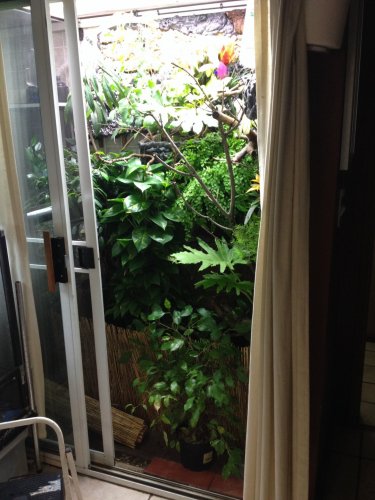
Q- What about lighting?
A- Lots of people say use the UVB 5.0 or Arcadia 6%. If you have a large cage, one where the animals will usually be more than 12" away from their lights AND they have lots of shady places to go, I use the Arcadia 12% bulb. Each Parson cage lighting consists of a Quad fixture with one UVB bulb, one plant light, and two 6500k white lights. My animals can get as close as 12" to the lights or as far away as 5 feet if they want to go to the bottom of their habitats, but even then they don't have to. All my cages have areas of dense foliage with horizontal branches going in. If the animals want some shade they use it, and unlike some chameleons, Parson's really like the shade. I have never seen one of mine bask under a heat lamp.This of course could vary depending on your climate. A cold Parson could use a basking light possibly for one example. I don't use them myself. When it comes to sunning themselves outside they don't do it for long. Despite that, giving any chameleon natural sunlight should be done when possible. During the months when weather permits I put them outside for a week at a time but most of that time they like to stay in the denser foliage and only come out for a brief amount of time into the sunlight. Yes...I've sat outside and watched them or used cameras...the buggers don't care about sunning as much as I thought they would. Now a Panther on the other hand will do that quite a bit by comparison.
As for an outside cage, here's what I made. However the bugger doesn't sun himself much.
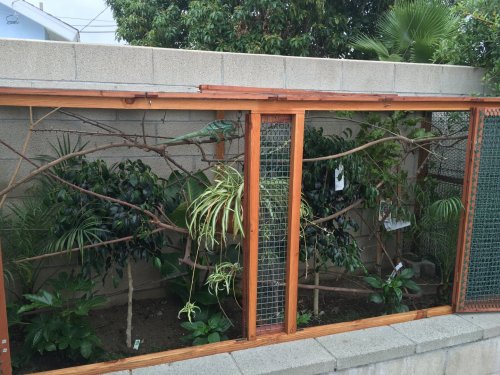
That was when it was new, now the plants have filled out and it is very very dense, just the way he likes it. Before he didn't use much of the space but now he roams it always sticking with the foliage. He has misters and a single sprinkler inside he uses on warm or even hot (90F) days.
